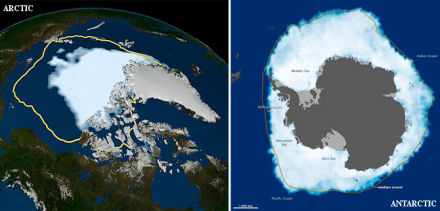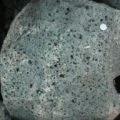While the dramatic decline in Arctic sea ice cover over the last three decades has been well documented, NASA climatologists say something more complex is happening at the other end of the planet. Their study shows that from 1978 to 2010 the total extent of sea ice surrounding Antarctica in the Southern Ocean grew by roughly 6,600 square miles every year. And the researchers say the increase in ice cover is accelerating.

Using satellite data, Parkinson and colleague Don Cavalieri showed that sea ice changes were not uniform around Antarctica. Most of the growth from 1978 to 2010 occurred in the Ross Sea, which gained a little under 5,300 square miles of sea ice per year, with more modest increases in the Weddell Sea and Indian Ocean. At the same time, the region of the Bellingshausen and Amundsen Seas lost an average of about 3,200 square miles of ice every year.
Another recent NASA study showed that Antarctic sea ice slightly thinned from 2003 to 2008, but increases in the extent of the ice balanced the loss in thickness and led to an overall volume gain.
Parkinson and Cavalieri said that the mixed pattern of ice growth and ice loss around the Southern Ocean could be due to changes in atmospheric circulation. Recent research points at the depleted ozone layer over Antarctica as a possible culprit. Ozone absorbs solar energy, so a lower concentration of this molecule can lead to a cooling of the stratosphere (the layer between six and 30 miles above the Earth’s surface) over Antarctica. At the same time, the temperate latitudes have been warming, and the differential in temperatures has strengthened the circumpolar winds flowing over the Ross Ice Shelf.
“Winds off the Ross Ice Shelf are getting stronger and stronger, and that causes the sea ice to be pushed off the coast, which generates areas of open water, polynyas,” explained NASA’s Josefino Comiso. “The larger the coastal polynya, the more ice it produces, because in polynyas the water is in direct contact with the very cold winter atmosphere and rapidly freezes.” As the wind keeps blowing, the ice expands further to the north.
This year’s winter Antarctic sea ice maximum extent, reached two weeks after the Arctic Ocean’s ice cap experienced an all-time summertime low, was a record high of 7.49 million square miles, about 193,000 square miles more than its average maximum extent for the last three decades.
The Antarctic minimum extents, which are reached in February, have also slightly increased to 1.33 million square miles in 2012, or around 251,000 square miles more than the average minimum extent since 1979.
The numbers for the Antarctic, however, pale in comparison with the rates at which the Arctic has been losing sea ice – the extent of the ice cover of the Arctic Ocean in September 2012 was 1.32 million square miles below the average September extent from 1979 to 2000.
Parkinson said that the fact that some areas of the Southern Ocean are cooling and producing more sea ice does not disprove a warming climate. “Climate does not change uniformly: The Earth is very large and the expectation definitely would be that there would be different changes in different regions of the world,” she explained. “That’s true even if overall the system is warming.”
Related:
Discuss this article in our forum
Arctic warming causing increased snowfalls?
Forests set to return to Canada’s extreme north
CO2 “inertia” makes significant climatic disruption inevitable
Ozone hole closure not so cool


















Comments are closed.